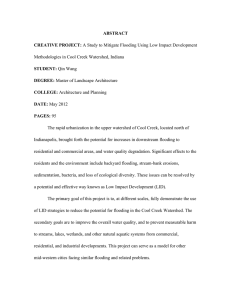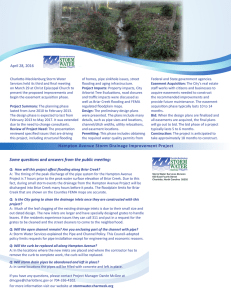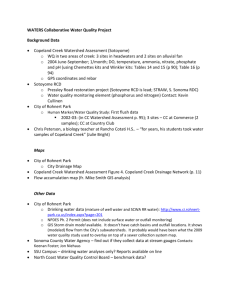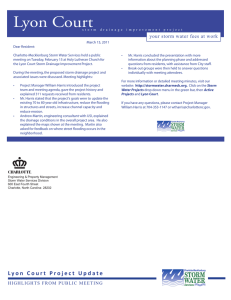US I MEETING MINUTES NFRASTRUCTURE OF CAROLINA, INC.
advertisement
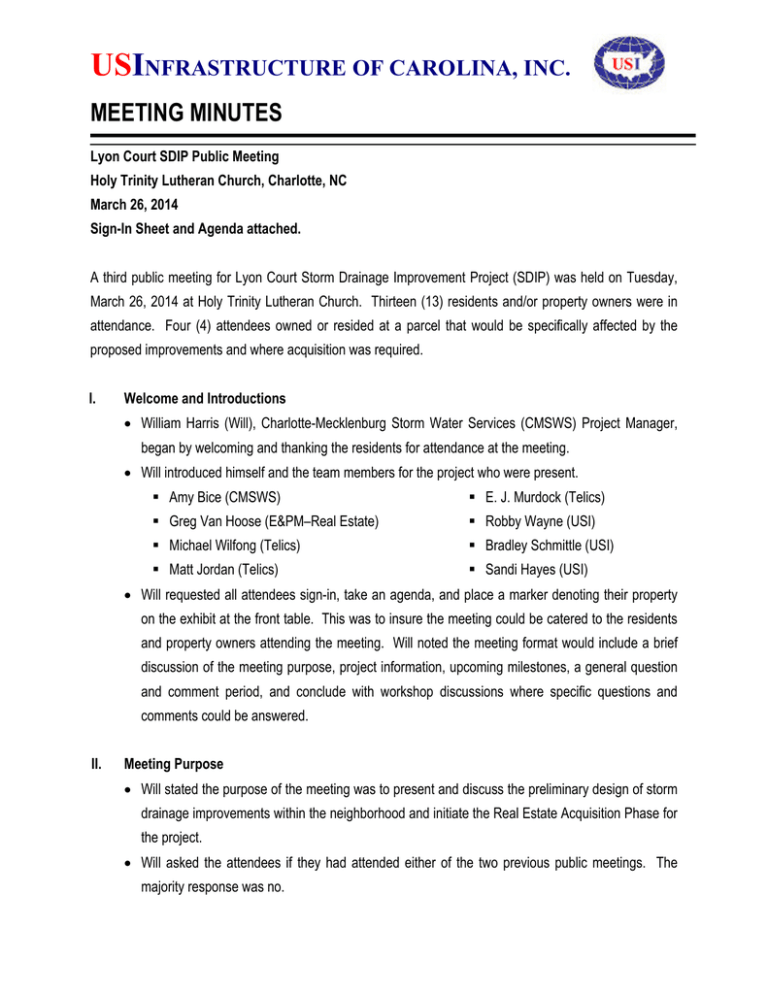
USINFRASTRUCTURE OF CAROLINA, INC. MEETING MINUTES Lyon Court SDIP Public Meeting Holy Trinity Lutheran Church, Charlotte, NC March 26, 2014 Sign-In Sheet and Agenda attached. A third public meeting for Lyon Court Storm Drainage Improvement Project (SDIP) was held on Tuesday, March 26, 2014 at Holy Trinity Lutheran Church. Thirteen (13) residents and/or property owners were in attendance. Four (4) attendees owned or resided at a parcel that would be specifically affected by the proposed improvements and where acquisition was required. I. Welcome and Introductions William Harris (Will), Charlotte-Mecklenburg Storm Water Services (CMSWS) Project Manager, began by welcoming and thanking the residents for attendance at the meeting. Will introduced himself and the team members for the project who were present. Amy Bice (CMSWS) E. J. Murdock (Telics) Greg Van Hoose (E&PM–Real Estate) Robby Wayne (USI) Michael Wilfong (Telics) Bradley Schmittle (USI) Matt Jordan (Telics) Sandi Hayes (USI) Will requested all attendees sign-in, take an agenda, and place a marker denoting their property on the exhibit at the front table. This was to insure the meeting could be catered to the residents and property owners attending the meeting. Will noted the meeting format would include a brief discussion of the meeting purpose, project information, upcoming milestones, a general question and comment period, and conclude with workshop discussions where specific questions and comments could be answered. II. Meeting Purpose Will stated the purpose of the meeting was to present and discuss the preliminary design of storm drainage improvements within the neighborhood and initiate the Real Estate Acquisition Phase for the project. Will asked the attendees if they had attended either of the two previous public meetings. The majority response was no. III. Project Information Will stated the SDIP’s goals were to update the existing infrastructure, reduce the flooding at structures and streets, increase channel capacity, and reduce erosion. Will informed the residents the Lyon Court SDIP watershed is approximately 350 acres in area and the project limits are generally bounded by The Plaza to the West, Belvedere Avenue to the North, Truman Road and Morningside Drive to the East and McClintock Road to the South. Will noted the neighborhood was built during the early 1900’s and the design standards at the time were much different than current standards. As a result, there is a lack of storm drainage systems and many of the existing systems are undersized or are in poor condition. Previous data collection, survey, modeling, analysis, citizen input, etc. conducted as part of the Planning Phase was used to develop the recommended improvements for design and implementation. Will referenced the exhibits highlighting the locations of proposed improvements and explained the legend. He noted the large color exhibits present the overall improvements and the preliminary construction plans provide specific detail related to location and impacts. Note: several copies of the exhibits were provided for the attendees to review and are attached for reference. IV. What Happens Next? Will noted the construction plans are approximately 70% complete and the Real Estate Acquisition Phase is being initiated. Over the next several weeks, Real Estate agents would be contacting all affected property owners to discuss the project and any temporary or permanent easements needed. Acquiring the easements could take between 8 to 12 months. Finalizing the construction plans and obtaining required permits will overlap the Acquisition Phase. Typical permits needed for storm drainage projects include a Sedimentation and Erosion Control permit, Water Quality permits from the North Carolina Department of Environment and Natural Resources and the U.S. Army Corps. of Engineers, Mecklenburg County floodplain development permit, etc. The Lyon Court SDIP is a very large improvement project. Construction is planned to occur in two (2) phases and each phase will take approximately two years. The construction start date for the Phase I is anticipated for late 2015/early 2016 with Phase II anticipated for 2018/2019. Construction is expected to be completed in 2019/2020. Will introduced Greg Van Hoose who is the City’s Senior Real Estate Agent that will be leading the Real Estate activities for the project. Greg briefly described the City’s Real Estate process and noted that agents will be contacting affected property owners in the near future to schedule appointments to discuss the project, 2 specific impacts to their property, and the documents utilized with acquisition. Greg also described the type of easements that may be needed to construct and maintain the improvements: temporary construction easements, permanent storm drainage easements, permanent utility easements, etc. Greg referred the attendees to CMSWS project website and the City’s Real Estate Division site where general information is provided. Will concluded the presentation and invited the attendees to ask general questions or provide comment related to the project. V. General Questions & Comments Question: “Is this the project that is working in the Floodway?” Response: Will responded by stating this project was not part of the Briar Creek Relief Sewer Project – Phase 2 sponsored by the Charlotte-Mecklenburg Utility Department. CMSWS projects improve the function and capacity of City drainage systems upstream of FEMA regulated floodplains. Although our project will be working on the Morningside Drive culvert and sections of the channel upstream and downstream, the project will not be constructing improvements to Briar Creek, a FEMA regulated stream. Louise Avenue, Beckwith-Meadow, and Chatham Storm Drainage Improvement Projects are three other CMSWS sponsored projects near the Lyon Court SDIP. Question: “Does FEMA regulate any of the flooding in this neighborhood?” Response: FEMA regulates the floodplain and floodway of Briar Creek, which is where the Lyon Court watershed drains. However, FEMA limits their regulation to areas of 1 square mile or greater, and this area has a total area of about a half square mile. FEMA does not regulate the tributaries in the Lyon Court SDIP watershed. Question: “What will keep Morningside from flooding more and could the project make the existing flooding on Briar Creek worse?” Response: Will responded by assuring the attendees the analysis and evaluation of alternatives investigated during the Planning Phase included an impact analysis to all properties within the project limits and along Briar Creek, the FEMA stream. The purpose of an impact analysis and evaluation is to protect downstream properties and infrastructure from increased flooding damage, to protect downstream channels from increased erosion potential due to project improvements, and to protect public health and safety in accordance with the requirements of City of Charlotte Storm Water ordinances and regulations. There are no anticipated adverse impacts to downstream properties or the FEMA stream from the project. However, the project will not eliminate indirect flooding that may occur during heavy or large storm events because of water levels along Briar Creek. In addition to the detailed analysis with the proposed improvements, the Briar Creek watershed is significantly 3 larger than the Lyon Court SDIP watershed and its peak (or wave of flow) is well after the Lyon Court SDIP peak. Also, there are no known FEMA sponsored projects within the area. Question: What does stream improvements entail, adding rock? Will the project be replanting vegetation? How much vegetation will be removed?” Response: The majority of channel improvements for the streams include reconstruction of the channel, planting the banks with vegetation, and using natural materials for stabilization. The improvements involve increasing the capacity of the channels and restoring natural habitat in and around the channel. The U.S. Army Corps of Engineers regulates stream improvements, and they typically require more environmentally friendly solutions. However, some areas require only stabilization or are located in areas where and adding rock or other structural components is the most appropriate option. Question: “Will a pond be included with the project – we don’t want to have another like the one constructed by the developer?” Response: Will stated there are no permanent ponds planned with the project. One of the goals of the project during and after construction will be to minimize sediment and erosion associated with the drainage systems. The project will be obtaining a Sedimentation and Erosion Control permit that will regulate and monitor construction activities. He noted he is familiar with the existing pond referenced. The existing pond is really a temporary sediment basin that was not maintained. Unfortunately the development had financial issues, the development stopped, and there was a time period when there was no owner or responsible party to address the lack of maintenance at the existing basin. Question: “I didn’t attend the previous meetings. How bad is the flooding in our neighborhood? Response: The team presented exhibits that were provided during the first public meeting. The exhibits summarized and depicted the existing condition of the drainage systems within the watershed: previous and current requests for service and the level of service provided for all segments of the drainage system. Will noted that a significant length of the system did not meet current standards, was in poor condition, or did not provide adequate conveyance for the runoff within the watershed. He also invited the attendees to review the exhibits in detail during the workshop discussions. Question: “Will the trees along Thurmond Place be removed?” 4 Response: The improvements in this area include constructing a supplemental system within the existing right-of-way that will minimize impacts to property owners and existing vegetation. Question: “Will roads be closed in order construct improvements? Morningside Drive was closed for over six months?” Response: There will be some road closures on the streets within the watershed, but the closures are temporary. The team has worked with the Charlotte Department of Transportation and developed traffic control plans for the project that include detours and lane closures for the roadways. A tunneling operation is planned for Central Avenue so that the thoroughfare will not be closed for traffic and impacts can be minimized. Basically, the proposed pipes will be tunneled underneath the roadway and only lane closures (one is each direction) are expected at this location. Question: “How will you fix street flooding?” Response: There are issues with lack of drainage structures, catch basins and inlets, along the existing curb and with undersized culverts. The first issue affects the efficiency of the existing structures to pick up the water coming down the street. With the lack of structures you see water run by the existing structures and to the next inlet. As a result, there is too much runoff or water ponding in the low point of the street. The improvements include adding additional catch basins and inlets to intercept the water and installing larger pipes and culverts to convey the runoff downstream. Question: “Is money an issue for this project?” Response: This project is funded by CMSWS. It is a high ranking priority project and funding has been allocated. The estimated total construction cost is between $10 and $12 million. The formal presentation was concluded after a general Question and Comment period. The team requested attendees share the information presented and team contact information with their neighbors who could not attend the meeting. Specific questions were also answered by team members during the workshop discussions that followed. VI. Workshop Discussions Property Owner Comment: “I have serious concerns about erosion behind my garage on Lyon Court. Tree just came down behind it and the creek is cutting in aggressively there.” Team to investigate stabilization 5 improvements through maintenance now and including permanent improvements as part of the project. Property Owner Comment: “Concerns with ponding at existing drop inlet in yard. Can grading be included with the project to help the inlet drain?” Property owner indicated interest in donating an easement if regrading around the existing structure can be included with the project. Team will investigate existing easements for adjacent parcels for potential access to structure and including improvements with the project. Property Owner Comment: “We have continuous problems with our sewer lateral and had a sump pump installed. The connection to the main sewer is along Nassau and appears to be going uphill. Since the City is replacing the existing sewer manhole and line along the property line, would it be possible to include relocation of our lateral connection if we pay for the costs?” Team will investigate. Property Owner Comment: “Are there other options instead of gabion baskets to stabilize the channel banks on my property?” Owner stated he will discuss with the Real Estate agents and the team will investigate. Property Owner Comment: “Can the large tree on the channel bank be saved? Yes, the current plans show tree protection at this location. Attendee Comments: “Topography has changed in area behind the County parcel”. Team to investigate. “The large 42” hardwood at the corner of Landis and Randall is dead and should be removed”. Team to investigate and will remove the tree protection symbols currently shown on the plans if warranted. 6
